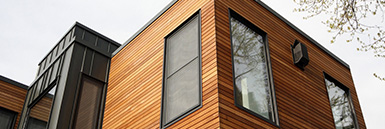The UK’s homes remain the least energy-efficient in Europe, representing 14% of the UK’s total carbon emissions. Future Homes Standard or ‘no’, that makes thermal performance key in window and door specification.
In light of the recent targets for new build windows published in the consultation on the Future Homes and Building Standards, it’s tempting to write off the part that u-values will play in shaping the window and door industry going forward.
U-values of 1.2W/m2K are comfortable to achieve, in theory anyway, for most systems, which suggests that the hiatus around potential changes from 2025 were little more than a storm in a teacup.
That analysis, however, according to Nigel, Headford, Director, Deceuninck Aluminium is too simplistic and fails to recognise big opportunities around energy efficiency.
“There is a sting in the tail in the consultation”, he says. “The proposed Home Energy Model is one. It could drive a move away from the standard window model in testing, to energy modelling against specific product dimensions.
“This could ultimately force some systems to step up to triple-glazing anyway, particularly older aluminium systems, as the glazed area of real-world windows will frequently be smaller than the standard window, so a 1.2W/m2K u-value is harder to achieve.”
This he argues, means that from a regulatory angle, the thermal performance in windows, retains a high degree of currency in window and door specification, but that putting this aside, the argument runs much deeper.
“Sustainability and Net Zero are important for the UK and UK homeowners. 84% believe that everyone will have to adopt home energy efficiency measures. That’s a big potential market”, Nigel adds.
A £249.5 billion market
This is drawn from figures published by UK Finance, a collective of the banking and finance industry, in its report into Net Zero Homes, and how the UK should get there.
It found that up-front costs were the biggest barriers to energy efficient home improvements (45% of respondents), arguing that the finance sector needed to adapt its models to facilitate green home improvements, for example green mortgages.
It estimated that to bring the entire UK housing stock up to an Energy Performance Certificate C Rating it would create a market worth £249.5billion.
Win business through Net zero
Nigel argues that the movement towards green finance, will be a key driver of sustainability going forward, and that those UK consumers who look to take advantage of it, will by definition be those with a direct interest in net zero and enhanced energy efficiency.
Taken to its logical conclusion, this he argues creates big opportunities for window and door companies who capitalise on the thermal performance of their offer.
“Aluminium attracts a different demographic. It’s an aspirational purchase, people are buying into a lifestyle. They do more research into performance”, Nigel argues.
“If we can communicate the benefits effectively to those prospects and as more green finance packages become available, the market for products, which deliver a higher level of thermal performance also grows.
“2025 was meant to be about regulatory change. It’s not going to be. It’s going to be about societal change.”
Advanced thermal performance – the Decalu 88 Flush Casement
The Decalu88 Flush Casement was launched by Deceuninck Aluminium in March last year with headline u-values are as low as 0.8W/m2k – a Passivhaus equivalent level of performance.
It also achieves u-values as low as – 1.2W/m2k with a standard unit – which means it meets current new build regs without the uplift in cost or complexity of going to triple-glazing, and future-proofs the system in home improvement and retro-fit markets.

Nigel continues: “The Decalu88 casement immediately creates an opportunity to up-sell in retail on thermal performance and aesthetics as well as providing an entry point in design-led specification.
“It was designed by the UK team to meet what we believed were going to be new requirements for Part L of u-values of as low as 0.8W/m2k. We know that that is no longer a regulatory requirement but it doesn’t mean that it doesn’t deliver big opportunities.
“What would you choose for your home?”
The Decalu88 Flush Casement is built around a patented thermal break which helps to deliver its advanced thermal performance.
In common with the Decalu88 Bi-folding Door, it also features a knock-in glazing bead with a flush finish pre-inserted gasket.

With a flush finish internally as well as externally, the Decalu88 Flush Casement is available from Deceuninck Aluminium in dual-colour and metallic finishes, and marine grade, as standard.
Concluding thoughts
“The industry has been building towards what we thought was going to be a step change in requirement for the for thermal performance, driven by regulation”, Nigel says.
“The dust needs to settle on the consultation and regulatory requirement as there are still a number of variables.
“What is certain is a shift in consumer awareness of the part they can play in lessening the impact of climate change which is coinciding with the launch of new green finance packages, aimed at supporting them in energy efficient retrofits.”
For more information call 01249 816 969, email info@deceuninck.co.uk or visit www.deceuninckaluminium.co.uk

